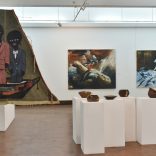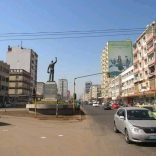Mozambique: 'Women, Art and Healing' at Núcleo de Arte - celebrating the strength of starting over
Mozambique: Malangatana Digital underway – Watch

File photo: Rádio Moçambique
The Malangatana family intends to open a Digital Interpretation Centre in 2026 to immortalize the man who was from 1936 to 2011 one of the greatest protagonists in the history of visual arts in the country.
The inauguration of the centre would coincide with the celebration of Malangatana’s 90th birthday, were he still alive.
The centre will make works, archives and other material available in electronic format to make the artistic contribution of the Mozambican artist, with an emphasis on painting and sculpture, known to a wide audience.
The initiative was recently announced by artist’s son, Mutxhini Ngwenya, who said the collection of material that will make up the historical and bibliographic collection of the essential icon of Mozambican culture had already begun.
“The documentation centre will be in Matalana, in Maputo province, and hopes to make the collections available to citizens from anywhere in the world who want to learn about Malangatana’s achievements,” he said.
Mutxhini stated that the initiative is open to the public and asked for support from individual or institutional entities to move forward with the project and the celebration of the artist’s 90th birthday.
The centre will focus on one of the most famous painters in the country’s history. Known for his work in the areas of painting and sculpture, he is considered one of the great icons of contemporary African art.
Born in Matalana, in the district of Marracuene, in Maputo province, he worked as a servant and a ball boy before being encouraged to draw and paint by biologist Augusto Cabral and, later, by architect Pancho Miranda Guedes.
The centre will demonstrate why his talent is recognised in various forms of art such as drawing, watercolour, tapestry, ceramics, engraving, monumental sculpture in iron and cement, and murals.
It will also explore Malangatna’s versatility – he was also a poet, singer, playwright, musician and dancer – and recall how Malangatana exhibited his work for the first time in 1959 at the Lourenço Marques Visual Arts Salon (now Maputo).
After Mozambique gained independence (1975), Malangatana took part in numerous group exhibitions in and outside the country. In 1986, he held a retrospective in Maputo.
In the 1990s, Malangatanae held political office as a Frelimo deputy and in the Municipal Assembly of Maputo, and was re-elected in 2003.
The centre will also list the honours he has received. In 1995, for example, he received the Nachingwea medal for his contribution to Mozambican culture and was invested as a Grand Officer of the Order of Prince Henry the Navigator by the Portuguese government. In 1997, he was named “Artist for Peace” by the United Nations Educational, Scientific and Cultural Organisation (UNESCO) and received the Prince Claus Prize. He was awarded a Doctor Honoris Causa in 2010 by the University of Évora and the decoration, awarded by the French government, of Commander of Arts and Letters.
Watch the TVM report on this project:












Leave a Reply
Be the First to Comment!
You must be logged in to post a comment.
You must be logged in to post a comment.